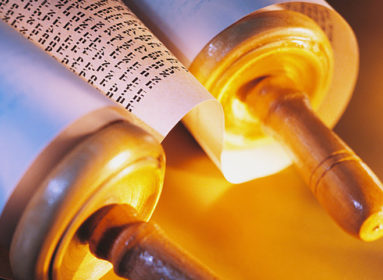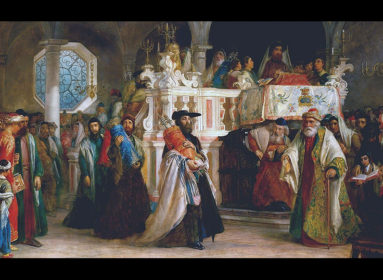
By Shlomo Riskin
We left Jacob last week leaving Laban and Laban-land behind, heaven-bent on returning to the land of Abraham and to the house of Isaac. Jacob understands that his inner self has been overtaken by the deceitful and aggressive hands of Esau, that he must return to his ancestral home in order to recapture the Abrahamic birthright. But what exactly are the building blocks of this birthright? Is it possible that Esau is now even more deserving, or at least as deserving of it as is Jacob? What is the real content – and significance – of our Jewish birthright? The very first prerequisite for the carrier of the birthright is a very strong Hebrew identity, a powerful familial connection that contributes – and defines – the link to a specific and unique heritage and ancestry.
Abraham established his commitment to the Hebrew identity when he insisted upon purchasing a separate gravesite for his wife Sarah, when he was willing to spend a small fortune in establishing a Hebrew cemetery beyond the various sites of the Hittites. He defines himself as an alien resident, sees himself as living amongst the Hittites but certainly not as being existentially a Hittite, and therefore refuses an “of right” burial for Sarah in any Hittite plot of land (Gen. 23:3-20).
Esau certainly is biblically described as having a strong sense of familial identity. He demonstrates strong feelings of filial respect and devotion; the Bible even records that Isaac loved Esau because he made certain to provide his father with the venison he dearly loved (Gen. 25:28). He even has strong sibling ties to his brother, despite Jacob’s underhanded deception surrounding the blessings. In the Torah portion this week, the Bible tells us how Esau first seemed to have set up a greeting brigade of 400 potential warriors to “welcome” the return of the prodigal brother (32:7); but once Esau actually sees his younger brother and his family, his heart apparently melts with brotherly love: “Esau ran to meet him; he hugged him, fell upon his neck and kissed him” (33:4). Esau even wishes for the two of them to travel together and to settle down together. “Let us travel together and move on; I will go alongside of you” (33:12). It is Jacob who politely refuses: “You know that my children are weak and I have responsibility for the nursing sheep and cattle. Please go ahead of me I shall eventually come to you in Seir” (33:13-14).
Yes, Esau has strong familial identity. However, Abraham had two other crucial characteristics that Esau lacks: continuity and destiny. Continuity is most meaningfully expressed in marrying a suitable mate: from our modern perspective, taking a Jewish spouse (so that the children will remain Jewish), and from the biblical perspective, not marrying an immoral Canaanite. Esau takes Hittite wives. Moreover, when he realizes how upset his parents are with his marital choice, he still doesn’t look to his mother’s family in Aram Naharayim for a mate, but rather chooses a daughter of Ishmael, the “wild ass of a man whose hand is over everything.” And he takes this wife not instead of but in addition to his Hittite wives.
Another test for continuity is a unique daily lifestyle, the ability to delay gratification and act with discipline, especially in the sexual and gustatory realms. The biblical kashrut laws for Jews have always been a powerful tool in keeping us a “nation set apart” which didn’t fall prey to assimilation. Esau sells his birthright for a portion of lentil soup. He even expresses his desire to have the broth “poured into his mouth” as one would feed a camel (25:30, see B.T. Shabbat, P.155 b, Rashi ad loc). To have one’s eyes on a historic mission, to realize the goal of having “all the families of the earth blessed by us” (Gen. 12:3) through our vision of a God of compassionate justice, morality and peace (Gen. 18:19), requires a lifestyle of commitment to an ideal and delayed gratification which is foreign to – and even impossible for – the character displayed by Esau.
Jacob then continues to travel to Succoth, which implies the tabernacle and the Holy Temple, the place in Jerusalem from where our message to the world will eventually emanate (Isaiah 2, Micah 4). But before Jacob can affirm his covenantal continuity and begin to achieve his destiny, he must first disgorge the grasping hands of Esau which have overtaken his personality and substituted the Jacob (Yaakov) of “he shall emerge triumphant at the end” with “heel-sneak”; he must restore his “image of God,” which was the source of that “wholehearted individual who was a studious dweller in tents.” This is the purpose of that mysteriously eerie nocturnal struggle with an anonymous assailant, a wrestling match that must precede the Esau-Jacob face-to-face confrontation. Jacob is all alone (32:25); his struggle is an inner battle, to rid himself of the heel-sneak Esau in his soul. He wins, both over divine forces and human powers (32:29); he has seen God (Elohim) face-to-face, and succeeded in restoring his own divine image by exorcising Esau the heel-sneak. He now proudly stands Israel, the righteous representative of God and the fitting recipient of the Abrahamic birthright.
Rabbi Shlomo Riskin is chancellor of Ohr Torah Stone and chief rabbi of Efrat, Israel.









 Southern New England Jewish Ledger
Southern New England Jewish Ledger













